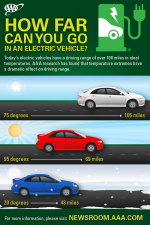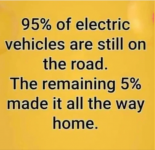I'm not about to drive anything with a 1000+ pound bomb on board.
Li ion batteries may be the most energy-dense, but they can be dangerous. They won't stand overcharge and the charging must be monitored and controlled via microprocessor/microcontroller. And we all know that firmware never crashes, right? In past years, the radiation from a cellphone could disrupt a micro (not so much now). Add to that ESD, electrical noise from on-board electronics, a trucker passing by with a 100W linear on his CB or a myriad of other possibilities.
There are many restrictions regarding Li ion batteries on planes.
And I'm pretty certain lithium mining is not green at all, nor disposal of used batteries. Remember, lithium is used for manic depression. So, what about lithium miners being exposed at length?
If/when they can demonstrate a viable electric passenger plane, I'll consider an EV. Until then, petroleum is the most energy-dense and economically feasible solution.
Not only will I not buy an electric car/truck, I won't fly in an electric airplane....
(this also fits in the "what could possibly go wrong" catagory)
Electric Vehicles to Hit the Skies: Air Canada Orders 30 Plug-In Planes, But Only a Few Passengers Can Ride

By
Mike Landry September 17, 2022 at 6:14am
You still can’t pack a lithium battery in your checked luggage, but by decade’s end you may be held aloft by aircraft engines powered by lithium batteries.
Thursday, Air Canada
announced a purchase agreement with Heart Aerospace for 30 of its 30-passenger ES-30 electric-hybrid aircraft it plans to put into service in 2028.
Last year, United Airlines announced the purchase of 100 Heart Aerospace 19-seat all-electric ES-19 planes, and its regional partner, Mesa Airlines (probably better know as United Express), said it was also purchasing 100 ES-19 aircraft,
Business Insider reported.
United’s venture capital fund, United Airlines Ventures, joined Breakthrough Energy Ventures and Mesa Airlines in investing in Heart Aerospace, a Swedish startup, with hopes of taking delivery of ES-19 planes by 2026.
Electric planes operate completely on battery power; electric-hybrids feature on-board supplemental generators that use standard aviation fuel.
Trending:
Harvey Weinstein Makes Urgent Request to Judge After Learning What Prison Dentist Has Planned for Him
The electric or electric-hybrid aircraft are envisioned for use in short-haul regional and commuter service. Turboprop planes have long been used in this service but customer demand forced regional carriers to switch to small jets.
Using jets for short hauls is very expensive, according to a
Business Insider report from 2020. Electric planes are limited in range, but with lower operating costs than jets, they might be workable in regional service.
That’s apparently the direction Air Canada, United and Mesa are going — electric vehicles for short hauls.
The goal of the ES-19 is a range of 250 miles by the end of the decade. Air Canada said the ES-30 hybrid can fly all-electric 124 miles and 244 miles with its supplemental generators. The range more than doubles to 500 miles if the plane carries only 25 passengers instead of 30.
But here come the problems. First of all, reduction of passenger load on the ES-30 to increase range is critical.
Airlines learned early that when an aircraft can safely and economically carry a certain number of passengers along with freight and required fuel, the addition of each passenger beyond that number represents almost pure profit.
The reason you find yourself crowded into that
noisy aluminum tube with barely enough room to breathe is that airlines are constantly striving to squeeze just one more person on board — the marginal cost of adding that last passenger is minimal, so the additional fare goes right to the bottom line.
Operators of the ES-30 will have to calculate serious economic trade-offs between passenger load and aircraft range.
Off course, trade-offs in aviation are nothing new — it has always been a battle among factors of weight, fuel, payload and gravity. Add more power and gravity loses, but more power requires more fuel and fuel has weight — so adding too much power to defeat gravity can lead to gravity winning.
In electric vehicles, the “fuel” is stored in lithium batteries. Battery service time has improved significantly in recent years, but lithium batteries are still heavy — and compared to jet engine output, they rank poorly in productivity.
Related:
Watch: Biden Needs to Be Pulled Out of Car, Then Something Fishy Happens - Was It a Disguise?
Currently, specific energy in watt-hours per kilogram of battery reaches about 250, while specific energy per kilogram of jet fuel is almost 12,000 watt-hours, Business Insider reported. Electric motors weigh less than jet engines — but that difference in potential energy creates a significant engineering challenge.
Safety is also an issue, of course. Today, due to fire hazard, when you board a plane, the airlines and the Transportation Security Administration make a big deal about keeping lithium batteries from being transported in cargo holds. But soon, the entire plane may be powered by lithium batteries.
Of course, the FAA regulates safety through certification of aircraft, but how serious will the FAA be in the face of the
ongoing drumbeat of anti-fossil fuel activists? After all, the big selling point of electric aircraft is the claim of zero emissions. (Review the sad case of
Boeing’s 737 Max to see how safety concerns sometimes crumble under pressure.)
Would you feel safe flying in an electric airplane?
I can’t say I like the idea of going aloft in a flying lithium battery. And that’s not an exaggeration. Omer Bar-Yohay, CEO of Israeli electric plane developer Eviation, said: “That battery’s literally all over the place. It’s under the floor, it’s in the wings, it’s in the fuselage in different locations.”
And the battery’s
volatility was
demonstrated when Eviation’s prototype electric plane Alice was damaged in 2020,
FlightGlobal reported. While the aircraft was being tested in Arizona a couple of years ago, its battery blew up, causing a fire.
Business Insider compared today’s lithium batteries to personal computers from the 80s — big, heavy, not very powerful. A lot has changed since then, obviously, and a lot of improvement in commercial batteries could be right around the corner.
Or maybe not. The first PC was developed in 1974, but the industry really began taking off in 1977. The first lithium battery was patented in 1976, so it’s not crazy to think its capabilities should have grown in a similar order of magnitude over a nearly identical period of time. That hasn’t happened.
As it stands, lithium batteries still have a lot of runway ahead of them.







